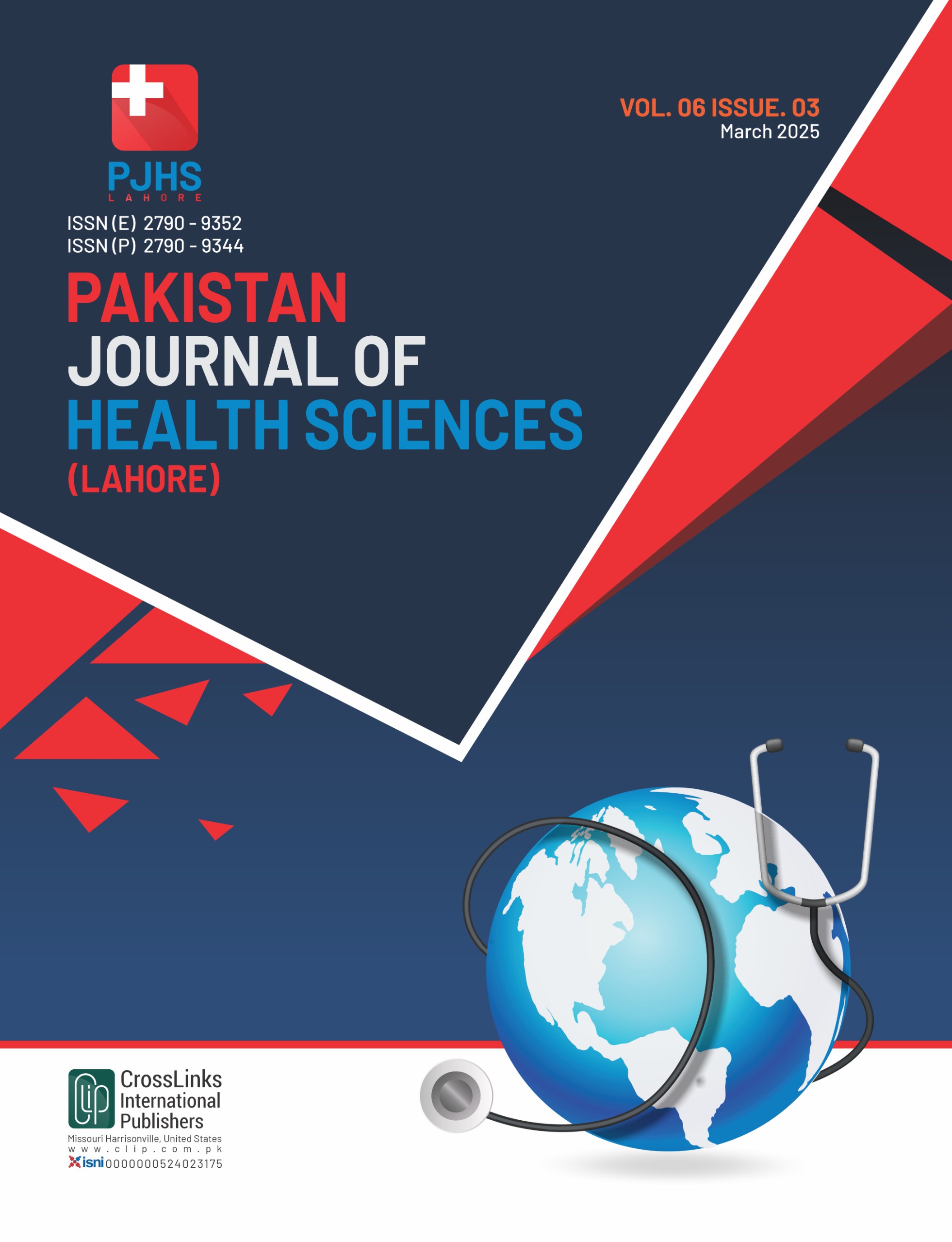Attitude Towards Tele-Medicine Among Caregivers of Pediatric Patients
Tele-Medicine Among Pediatric Patients
DOI:
https://doi.org/10.54393/pjhs.v6i3.2318Keywords:
Telemedicine, Parents' Attitudes, Pediatric Care, Technological Profiles, Digital HealthAbstract
Telemedicine is a vital constituent of digital health-care, particularly stating the deliverance of medical facilities over remote areas by means of Information and Communication Technologies (ICT). The swift progress of mobile applications has improved support for health-care experts, rationalization responsibilities such as time organization, communication, and policymaking. Objective: To assess attitudes of parents having children aged between one to twelve years towards telemedicine. Methods: The cross-sectional study employed an online survey with the sampling strategy as convenience method for recruitment of eligible parents. A self-administered questionnaire was employed to gather sociodemographic data, child-related information, and participants' technological profiles. Attitudes toward telemedicine were measured using a 5-point scale, evaluating the perceived usefulness of various telemedicine services and associated advantages. Data analysis included descriptive statistics to summarize sociodemographic variables and item prevalence, while excluding any missing values. Results: A total of 120 families participated in the study, with caregivers averaging 47.4 years in males, 43.1 in females and children 7.5 years old. The majority of caregivers were female (68.3%), and most children were male (53.3%). Technological profiles indicated high smartphone availability (93.3%) and moderate use of social media accounts. Attitudes toward telemedicine showed significant perceived usefulness, particularly for scheduling medical visits (54.1% rated it as moderate/much) and telemonitoring services (49.1%). Participants recognized advantages of telemedicine, highlighting time efficiency (44.1%) and financial savings (46.6%) as key benefits. Conclusion: Families of pediatric patients demonstrated a strong willingness to engage in telemedicine programs. They showed positive attitude towards usefulness of telemedicine.
References
Senbekov M, Saliev T, Bukeyeva Z, Almabayeva A, Zhanaliyeva M, Aitenova N et al. The recent progress and applications of digital technologies in healthcare: a review. International Journal of Telemedicine and Applications. 2020 Dec; 2020(1): 8830200. doi: 10.1155/2020/8830200. DOI: https://doi.org/10.1155/2020/8830200
Hui CY, Abdulla A, Ahmed Z, Goel H, Habib GM, Hock TT et al. Mapping national information and communication technology (ICT) infrastructure to the requirements of potential digital health interventions in low-and middle-income countries. Journal of Global Health. 2022 Dec; 12: 04094. doi: 10.7189/jogh.12.04094. DOI: https://doi.org/10.7189/jogh.12.04094
Gonçalves-Bradley DC, Maria AR, Ricci-Cabello I, Villanueva G, Fønhus MS, Glenton C et al. Mobile technologies to support healthcare provider to healthcare provider communication and management of care. Cochrane Database of Systematic Reviews. 2020 Aug; 8(8): CD012927. doi: 10.1002/14651858.CD012927.pub2. DOI: https://doi.org/10.1002/14651858.CD012927.pub2
Okolo CA, Ijeh S, Arowoogun JO, Adeniyi AO, Omotayo O. Reviewing the impact of health information technology on healthcare management efficiency. International Medical Science Research Journal. 2024 Apr; 4(4): 420-40. doi: 10.51594/imsrj.v4i4.1000. DOI: https://doi.org/10.51594/imsrj.v4i4.1000
Tapia SM. Running Naked: A Thematic Analysis of the Lived Experience Running with and Without Technology. California Institute of Integral Studies; 2023 Jul.
Karageorgos G, Andreadis I, Psychas K, Mourkousis G, Kiourti A, Lazzi G et al. The promise of mobile technologies for the health care system in the developing world: a systematic review. IEEE Reviews in Biomedical Engineering. 2018 Sep; 12: 100-22. doi: 10.1109/RBME.2018.2868896. DOI: https://doi.org/10.1109/RBME.2018.2868896
Zakerabasali S, Ayyoubzadeh SM, Baniasadi T, Yazdani A, Abhari S. Mobile health technology and healthcare providers: systemic barriers to adoption. Healthcare Informatics Research. 2021 Oct; 27(4): 267-78. doi: 10.4258/hir.2021.27.4.267. DOI: https://doi.org/10.4258/hir.2021.27.4.267
Haleem A, Javaid M, Singh RP, Suman R. Telemedicine for healthcare: Capabilities, features, barriers, and applications. Sensors International. 2021 Jan; 2: 100117. doi: 10.1016/j.sintl.2021.100117. DOI: https://doi.org/10.1016/j.sintl.2021.100117
Latif S, Rana R, Qadir J, Ali A, Imran MA, Younis MS. Mobile health in the developing world: Review of literature and lessons from a case study. IEEE Access. 2017 Jun; 5: 11540-56. doi: 10.1109/ACCESS.2017.2710800. DOI: https://doi.org/10.1109/ACCESS.2017.2710800
Mariwah S, Machistey Abane A, Asiedu Owusu S, Kasim A, Robson E, Castelli M et al. Formalising 'informal'mHealth in Ghana: Opportunities and challenges for universal health coverage (UHC). Global Public Health. 2022 May; 17(5): 768-81. doi: 10.1080/17441692.2021.1874467. DOI: https://doi.org/10.1080/17441692.2021.1874467
Alsswey A, Al-Samarraie H, Bervell B. mHealth technology utilization in the Arab world: a systematic review of systems, usage, and challenges. Health and Technology. 2021 Jul; 11(4): 895-907. doi: 10.1007/s12553-021-00549-3. DOI: https://doi.org/10.1007/s12553-021-00549-3
Anton K. Future Foresight into Application of AI Technologies in the Finnish Healthcare: Outlining prospective trends of development in primary care by 2030.
Assaye BT, Jemere AT, Nigatu AM. Knowledge and awareness of health professionals towards telemedicine services in Northwest, Ethiopia. Digital Health. 2022 Dec; 8: 20552076221143250. doi: 10.1177/20552076221143250. DOI: https://doi.org/10.1177/20552076221143250
Stoltzfus M, Kaur A, Chawla A, Gupta V, Anamika FN, Jain R. The role of telemedicine in healthcare: an overview and update. The Egyptian Journal of Internal Medicine. 2023 Dec; 35(1): 1-5. doi: 10.1186/s43162-023-00234-z. DOI: https://doi.org/10.1186/s43162-023-00234-z
Wasi Abbas M, Nawaz Tahir H, Jaffar N, Raza G, Aman Ali S, Jabeen R. Facilitators and barriers in acceptance of telemedicine among healthcare providers in Pakistan: A cross-sectional survey. The Journal of Medicine Access. 2024 Jul; 8: 27550834241266413. doi: 10.1177/27550834241266413. DOI: https://doi.org/10.1177/27550834241266413
Mahdi SS, Allana R, Battineni G, Khalid T, Agha D, Khawaja M et al. The promise of telemedicine in Pakistan: a systematic review. Health Science Reports. 2022 Jan; 5(1): e438. doi: 10.1002/hsr2.438. DOI: https://doi.org/10.1002/hsr2.438
Morrison KS, Paterson C, Toohey K. The feasibility of exercise interventions delivered via telehealth for people affected by cancer: a rapid review of the literature. InSeminars in Oncology Nursing. 2020 Dec; 36(6): 151092. doi: 10.1016/j.soncn.2020.151092. DOI: https://doi.org/10.1016/j.soncn.2020.151092
Vitacca M, Montini A, Comini L. How will telemedicine change clinical practice in chronic obstructive pulmonary disease?. Therapeutic Advances in Respiratory Disease. 2018 Feb; 12: 1753465818754778. doi: 10.1177/1753465818754778. DOI: https://doi.org/10.1177/1753465818754778
Edwards L, Thomas C, Gregory A, Yardley L, O'Cathain A, Montgomery AA et al. Are people with chronic diseases interested in using telehealth? A cross-sectional postal survey. Journal of Medical Internet Research. 2014 May; 16(5): e123. doi: 10.2196/jmir.3257. DOI: https://doi.org/10.2196/jmir.3257
Meininger L, Adam J, von Wirth E, Viefhaus P, Woitecki K, Walter D et al. Cognitive-behavioral teletherapy for children and adolescents with mental disorders and their families during the COVID-19 pandemic: a survey on acceptance and satisfaction. Child and Adolescent Psychiatry and Mental Health. 2022 Jul; 16(1): 61. doi: 10.1186/s13034-022-00494-7. DOI: https://doi.org/10.1186/s13034-022-00494-7
Lee JY, Du YE, Coki O, Flynn JT, Starren J, Chiang MF. Parental perceptions toward digital imaging and telemedicine for retinopathy of prematurity management. Graefe's Archive for Clinical and Experimental Ophthalmology. 2010 Jan; 248: 141-7. doi: 10.1007/s00417-009-1191-6. DOI: https://doi.org/10.1007/s00417-009-1191-6
Ramalingam M. Role of ICT in Telemedicine. InGeospatial Data Science in Healthcare for Society 5.0. 2022 Mar; 11: 227-272. doi: 10.1007/978-981-16-9476-9_12. DOI: https://doi.org/10.1007/978-981-16-9476-9_12
Su Z, Li C, Fu H, Wang L, Wu M, Feng X. Development and prospect of telemedicine. Intelligent Medicine. 2024 Feb; 4(1): 1-9. DOI: https://doi.org/10.1016/j.imed.2022.10.004
Downloads
Published
How to Cite
Issue
Section
License
Copyright (c) 2025 Pakistan Journal of Health Sciences

This work is licensed under a Creative Commons Attribution 4.0 International License.
This is an open-access journal and all the published articles / items are distributed under the terms of the Creative Commons Attribution License, which permits unrestricted use, distribution, and reproduction in any medium, provided the original author and source are credited. For comments













